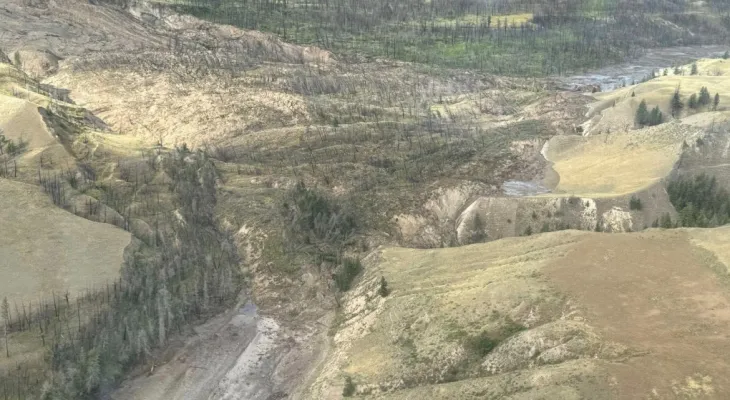Search here
Newspaper
Search here

Arab Canada News
News

Published: August 5, 2024
It is expected that the water flow over the dam caused by a landslide in the Chilcotin River will begin on Sunday night or early Monday morning, according to an update from officials.
The Ministry of Emergency Management issued a press release with the updated timeline, while reiterating its appeal for people to avoid the river between Hansville and the confluence of the Fraser River.
The statement says: "People are also advised to stay away from the banks of the Fraser River. Planning continues to address potential impacts of the debris regarding public safety."
"Risks to public safety include the possibility of further landslides above the natural dam and below the dam once water begins to flow through it."
Since July 30, a small amount of water has been leaking through the massive barrier—which is estimated to be about 30 meters deep, 1000 meters long, and 600 meters wide—and water levels behind the dam have been steadily rising by about 18 centimeters per hour.
However, models show that water is unlikely to burst suddenly through the dam, which regional officials stated would have been the worst-case scenario.
Officials say the best-case scenario—and the most likely—is that it will take 12 to 24 hours for the water to move through the barrier. This would lead to water levels dropping below typical spring flood levels on the Fraser River, but flows will still exceed peak freshwater levels in the Chilcotin River.
"Ultimately, this is an encouraging development for the communities downstream," said Emergency Management Minister Bowen Ma at a press conference on Saturday.
"Although it resembles the rises during fresh water flows, the water will react differently, with greater momentum and force, than the gradual rise in water levels," the release stated on Sunday.
The updated models now show that if the lake behind the dam drains quickly, within an hour, the flows would be higher than what was expected on Saturday. The latest release states that water levels will be "much higher" on the Chilcotin River and at or below spring snowmelt flows on the Fraser River.
According to the statement, "in this scenario, the water level in the Chilcotin River could rise to 21 meters at the Farwell Canyon Bridge and 12 meters where the Chilcotin River meets the Fraser River."
The evacuation order for 60 lots along the northern part of Chilcotin remains in effect, and officials have requested "people to stay away from the banks of the Fraser River."
They also urged the public not to use drones in the landslide area. The British Columbia Wildfire Service issued a notice to pilots on Friday, making the use of any aircraft in the area, not part of the landslide response, illegal.
Ma said on Saturday: "For the safety of the aircraft crew and the public, we ask everyone to stay away from the area, whether on the ground or in the airspace. This is extremely dangerous and poses a threat to both those returning to the area and the experts assessing the situation on the ground."
Officials confirmed on Sunday that the landslide could affect the salmon spawning in the area and said they are planning mitigation efforts.
The province also established a new online portal dedicated to sharing information about the landslide and the response from regional and local officials.
Comments